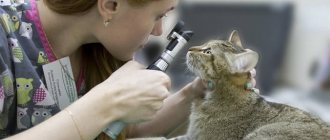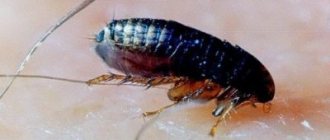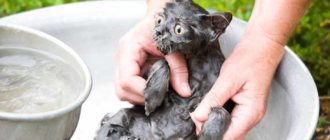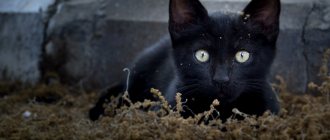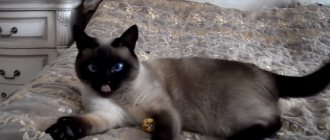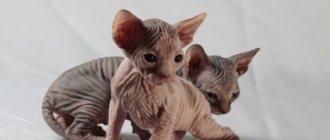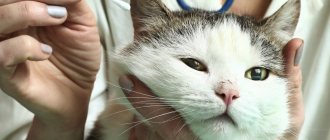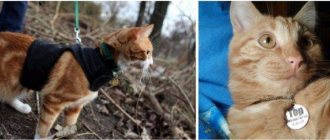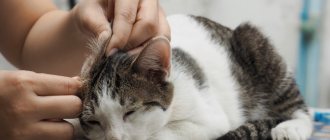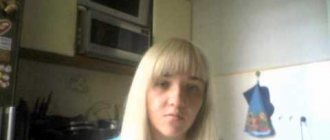What to feed a sick cat
Unfortunately, some owners treat their pets lightly, believing that purebred cats do not get sick, and if the pet gets sick, it will recover. This approach is very dangerous! Cats need prevention of viral diseases and parasitic infestations. An animal deprived of care is guaranteed to get sick or even die, it’s a matter of time.
What happens to a cat's body during illness? In fact, the symptoms that the owner sees are only a small part of the changes to which the body has to adapt. No matter what the cat is sick with, its immunity comes into tension, that is, leukocytes constantly multiply in the blood. The only exception is immunodeficiency, in which white blood cells die.
Constant cell division and the fight against disease requires enormous resources, so proper feeding of the cat during the period of illness plays a key role. Naturally, the cat’s recovery will depend on the efficiency and competence of treatment, comfort and care that the owner can provide.
Yes, here we are talking specifically about guessing and intuitive decisions. If you have the opportunity to regularly have your pet’s blood tested, that’s great, but if you don’t have the opportunity, you will have to act according to the situation. The diet of any animal should be rich in protein, vitamins, minerals, amino acids and fats. If a cat has lost weight or is exhausted, its diet is supplemented with carbohydrates, but one must not overdo it.
The diet of a sick cat should be selected taking into account the following factors:
- At high temperatures, friendly bacteria of the intestinal microflora die, that is, dysbiosis develops. In such a situation, the cat will only benefit from quickly and easily digestible foods.
- A sick animal has irritated mucous membranes, including the oral cavity and intestines. To facilitate the process of absorption and assimilation of food, it is better to grind the treats to the consistency of a pate.
- The calorie intake should strictly depend on the cat's needs. If the animal is exhausted, the veterinarian will prescribe nutritious food, such as those produced by some manufacturers of industrial animal feeding. If the pet is overweight, a diet is prescribed to reduce the percentage of fat mass, but taking into account the maintenance of vitality.
After surgical interventions, especially if the operation was difficult and resulted in several stitches, a light diet is prescribed. The point is that the cat should drink a lot and eat only dietary foods. This way, the cat will go to the toilet, mostly in small quantities, and will not strain its muscles to empty its bowels. If the operation was performed on the abdominal cavity, a light diet is prescribed until the sutures are removed. The exception is sterilization and castration. With modern methods, the cat can be returned to its usual diet within a day after surgery.
Most veterinarians recommend switching a sick animal to special industrial feed. Many people know that there are specially medicated foods designed for animals with:
- Allergies.
- Urolithiasis.
- Sensitive digestive system.
- Ailments of the musculoskeletal system and others.
As you can see, medicinal food is intended for animals with chronic pathologies.
There are also specialized foods for cats in critical condition, although their choice is much smaller. Typically, such products contain a lot of protein (70–85%) and a powerful vitamin complex. Rehabilitation feeds are available in liquid form (in tubes) or ground into a pate. In the first case, the food is used for force feeding; the pate is intended for cats that have an appetite and try to eat on their own.
Rehabilitation food is very tasty and aromatic, which encourages even a very weak cat to eat. If you are not sure whether your pet will eat, it is better to purchase food in a tube, since a weakened pet will be more likely to lap than chew.
Is it possible to feed a cat natural food during rehabilitation? In principle, it is possible, besides, about 5 years ago there were no feeds for rehabilitation and pets were nursed on natural food. To simplify the digestion process, the diet should include boiled meat, ground to a smooth paste, cottage cheese and fermented milk products. Meat pate can be diluted with broth to be drawn into a syringe or offered to the cat to lap from a saucer.
How to get a cat to eat?
I'm asking for advice. How to make a cat eat? He eats practically nothing (10-15 “crunches” of dry food per day). The diagnosis is chronic renal failure of the penultimate or last stage. I've already lost several kilos. During the IV drips I ate normally. After a day, it practically stopped. We take: Renalcin, pancreatin, smecta, canephron. Nutrition - diet on Royal Canin Renal. And maybe someone knows some methods of treating chronic renal failure other than droppers and injections (perhaps surgery?). According to tests: creatinine - about 600, amylase - 2300, urea - 20, ALT - 35, AST - 55.5, glucose - 3.9, hemoglobin - 67. Kidneys: one is in the stage of degeneration (there is still a small blood flow), the second – practically does not work – an ultrasound revealed a suspicion of a tumor, possibly a cyst. I saw a similar topic on the forum, they wrote about some kind of parenteral nutrition. What is it and how to take it? Thanks in advance for any help!
Oleg_g writes: The diagnosis is chronic renal failure of the penultimate or last stage. I've already lost several kilos. During the IV drips I ate normally. After a day, it almost stopped
Judging by the test data, the cat really has stage 4 chronic renal failure, that is, the terminal stage. Clinical manifestations confirm this. We will try to comment on your situation.
Oleg_g writes: We take: Renalcin, pancreatin, smecta, canephron.
During this treatment, it will be possible to support the cat a little, but at least once every 2-3 months it is necessary to carry out intensive therapy in order to cleanse the blood, because the kidneys almost do not work and toxins accumulate in the body. More on this below. Regarding the drug RENALCIN. Apparently you are from Ukraine, since so far only our sister country has certified this drug. I've heard good reviews, but haven't used it myself.
Oleg_g writes: Nutrition - diet on Royal Canin Renal
First, strictly dietary nutrition with medicinal food; if you refuse this food, try Purina NF or EUKANUBA Renal Formula, and gradually switch to another food, gradually adding a little to your usual food. Secondly, do not give dry food, only canned food for kidney disease.
Oleg_g writes: And maybe someone knows some methods of treating chronic renal failure other than IVs and injections (perhaps surgery?).
CRF [u INCUREABLE[/u . It is in your and our power to make your pet’s life easier, reducing his life to less discomfort. To do this, you need to periodically undergo a course of treatment, including droppers. However, I would recommend you prosmopheresis or hemodialysis (artificial kidney). It is rarely used in veterinary medicine because it is an expensive procedure, but it cleanses the blood very effectively.
Oleg_g writes: I ask for advice. How to make a cat eat?
There is an emphasis on low-protein nutrition, which is undoubtedly found in the feeds we talked about above. And to stimulate appetite, you can use peritol syrup 5 ml per cat orally 1-2 times a day for 5-7 days.
Force feeding
Before force-feeding your cat, make sure you are doing it in a way that is not harmful. Be sure to consult with your veterinarian to determine the reason for the refusal of food. Elementary, a cat may not eat food because its teeth hurt. You will start to force feed your pet, but this will not solve the problem and will not alleviate the condition.
If the pet is able to hold its head up, you should start by offering liquid food. Cats are given food in a saucer or offered to lick it off a finger. With all your appearance and actions, you should encourage your pet to eat. The moral side of the issue is very important, since the pet, no matter what state it is in, is guided by the owner and his emotions.
For a cat that cannot lift its head or lap, you can try placing food on the back of its tongue. You need to make a small ball out of the pate. Swallowing is provoked by stroking the throat. This method is not very convenient and most doctors in this case advise using a syringe. The food is prepared liquid and homogeneous, with the consistency of gruel. For convenience, use a large syringe, but do not fill it completely unless necessary. There is no point in feeding kittens and very weakened cats from a large syringe, since one serving should not exceed 2–5 ml.
You need a syringe without a needle; if the container is small, use a hot knife to remove the plastic spout. The cat may be interested in food, but it is possible that the pet will ignore all your impulses. If the cat does not open its mouth, you need to help it. Food should be squeezed out as close to the root of the tongue as possible.
In clinical settings, more effective methods of force feeding are used. In cats that are critically ill or have no swallowing reflex, a probe is inserted through the nasopharynx. The tip of the probe is passed to the stomach. Afterwards, through this tube and using a syringe, liquid food is injected into the animal’s stomach. In addition to force feeding, the pet’s body is constantly supported with the help of droppers with vitamins, minerals and buffer solutions.
Reasons for refusing water
To restore your cat's interest in water, change the bowl first.
If your cat won't drink water from his bowl, he may not like the dishes, or he may be drinking from a toilet, dripping faucet, bucket, or other kitchen container.
Psychological reasons for refusing water:
- uncomfortable bowl;
- there is stagnant water in the drinking bowl;
- food from a nearby bowl got into the liquid;
- after playing with water she became dirty.
Having identified the reason for refusing water, it is important to eliminate it.
Special diet for cats
Currently, on the zoological products market you can find a huge number of different ready-made foods that were specially designed to help cats treat a particular disease or group of diseases. Among them there are those that should be given to those cats that, being in a state of stress, refuse to eat.
How and what to feed a sick cat.
This type of food is specially produced in liquid form. This is necessary so that a cat that refuses to eat can be syringed-fed or so that it can lap up the food like water. In addition, such food is very tasty, which can force the cat to eat at least a little. It should be noted that a cat that does not want to eat, as a rule, is more willing to eat something liquid, simply lapping it from a saucer, than to chew something solid. This circumstance should be remembered by all those who keep cats, just in case. Such foods, among other things, are characterized by increased calorie content.
Should a diet be followed if the cat is sick?
In view of this, even a small amount of such food will be enough to ensure that a sick cat is provided with all the essential nutrients. However, this does not mean that an owner who sees that his cat is unwell can simply run to the nearest zoological store, grab a package of such food and feed it to his pet, thinking that this will solve all the problems. This, of course, is the wrong approach and you should first consult with a veterinarian and, if the veterinarian deems it necessary, bring the cat for an examination. And only after the veterinarian gives the go-ahead for the use of such food, does it make sense to buy it. In this case, the doctor must indicate exactly how much of this food the sick cat should eat.
As a rule, the daily dose of food is divided into five to six small servings. And so that readers can get a more accurate idea of how to care for a sick cat, we will give a number of recommendations.
A sick cat is in particular need of nutrients.
Firstly, to ensure that the cat does not lack nutrients, the owner will have to be patient, time and a certain ingenuity. He should also remember that:
- The food should be heated to approximately the cat's body temperature (about 38.5 degrees), which will make it more flavorful.
- If within fifteen minutes the cat has not eaten its food, then it (the food) can be removed. After some time, the animal can be fed again, and it is more likely to give preference to fresh foods rather than stale ones on the plate.
- Sometimes it makes sense to place small pieces of food on your cat's lips.
- Cats eat liquid food more readily than solid food, especially if the cat is sick.
- If the cat does not want to get up and go to the food bowl, you should feed it by hand.
Features of the appetite of pregnant and lactating cats
Methods that are suitable for increasing appetite in adult cats are not suitable for individuals bearing or nursing offspring. Since in pregnant cats loss of appetite is most often associated with the following reasons:
- toxicosis of pregnant women;
- intrauterine infection;
- injury received, for example, from a careless jump;
- constipation;
- a large number of gestating fruits;
- polyhydramnios;
- intrauterine death of offspring.
Read the article on how to tell if your cat is pregnant.
In case of toxicosis, to increase appetite, you can include in the diet foods containing a lot of protein, vitamins, micro- and macroelements.
To eliminate other problems, a mandatory consultation with a specialist is necessary, so you should immediately contact a veterinary clinic.
For proper nutrition of the female during lactation, it is important to monitor the balance, quality of food and abundance of foods in the diet. It must contain proteins, fats, carbohydrates, minerals, vitamins, and amino acids in the required proportions so that the cat produces enough milk to feed the cubs and does not lose weight itself.
The volume of portions and frequency of feeding a nursing cat depend on the number of kittens in the litter, but most often the female herself is able to regulate her diet.
Access to food and clean water should always be open. Do not leave perishable foods in the bowl.
If the cat is on dry food, then you should make sure that it is high-class - holistic or super premium, and it is better to use mixtures for kittens.
If your cat is on a natural diet, you need to make sure that its diet always contains the following products:
- Lean meat, poultry, liver. They should make up at least half of the daily diet.
- Porridges are low in carbohydrates; they will help normalize the functioning of the gastrointestinal tract.
- Greens, vegetables, fruits in small quantities. These are the main suppliers of vitamins, minerals, micro- and macroelements.
- Fermented milk products in limited quantities.
- Butter and chicken yolk in quantities strictly specified by experts to replenish the loss of polyunsaturated fatty acids.
Why does my pet refuse to eat?
When a kitten or adult is sick, the protective mechanisms of the immune system are reduced and the pet often refuses to feed. This reaction is normal for a weakened cat’s body, and owners should not worry too much or force-feed a sick cat. Usually the problem occurs in the first few days after an infection enters the animal’s body and another disease develops. After 2-3 days, the cat may ask for food on its own, or you should try to force-feed it with a small amount of food.
In most cases, the problem is associated with diseases of the gastrointestinal tract. The treatment process, during which the cat is given various drugs that reduce appetite, can affect impaired feeding. The reason may also be due to other factors:
A stressful state affects the animal's appetite.
- getting a foreign object into the throat or esophagus, which the pet cannot get rid of on its own;
- body bruise of varying severity;
- poisoning of the body;
- impact of stress.
Mr. Cat recommends: problem solving
In order to restore your pet’s appetite, you first need to figure out whether physiological or pathological causes lie at the root of the problem and only then solve it.
To prevent loss of appetite, it is necessary to provide your pet with a high-quality and nutritious diet.
If a cat’s complete or partial refusal to eat is not associated with illness, then there are several ways to return to normal appetite:
- Diversify your diet with fresh meat and poultry.
- If you have sensitive digestion, choose special foods.
- Avoid eating spicy and fatty foods, pickled and salty foods, and sweets.
- Sometimes raw chicken yolk helps as a stimulant. You should not give it to your cat more than once a week.
- Fish, grains and greens in limited quantities can also relieve digestive problems.
- Catnip is a good appetite stimulant.
Read the article about natural cat nutrition.
In order to identify exactly what problems led to the cat’s loss of appetite, you should proceed according to the following scheme:
- Try to interest your pet in a new tasty dish.
- Observe the animal for a few days, maybe it’s just a natural hunger strike. It should be remembered that it is harmful for a kitten not to eat for more than a day.
- If an adult cat’s appetite does not return within five days, you should contact a veterinary clinic and follow all doctor’s instructions.
- If vitamin complexes are prescribed, you should purchase them at a veterinary pharmacy. Now there are many preparations containing seaweed, catnip, yeast, and other micro- and macroelements. They are developed and produced specifically for cats and act, as a rule, by improving metabolism. Sometimes special sprouted grass helps.
- It may help to switch your pet to high-quality holistic or super premium dry food. Among the best brands are Acana, Orijen, Applaws, GO!.
How to process seams
It is very important to keep the seams clean and prevent infection and inflammation. The bandage should be changed to a clean one every day, and the seam should be treated daily with the antibacterial agent “Argumistin”, which will prevent inflammation, fungus, and infection with microbes during periods of special danger
The use of "Argumistin" has a number of advantages:
- eliminates the main cause of the disease;
- has an anti-inflammatory effect;
- activates the regeneration process;
- does not contain antibiotics;
- does not cause addiction in cats;
- ease of use;
- optimal price.
Monitor the progress of healing, treat the sutures daily, and in case of the slightest deviation, consult a doctor. The sooner complications are detected, the easier it is to prevent possible danger.
| veterinarian | Information on prices for drugs is indicative and is provided for reference; it does not constitute a public offer. |
Features of feeding in the first days
Any doctor will tell you that anesthesia is a difficult test for the body. For an animal that does not understand what happened and why, it is doubly difficult. Therefore, the first day after the operation, you should not only make sure that the cat is in its usual, familiar environment, but also carefully monitor the pet. An animal can very easily get hurt or cause other harm to itself, since at first there is a lack of coordination and a change in behavior.
Today, there are no problems with the nutrition of sterilized cats: the market offers not only a wide selection of premium food with various veterinary lines, but also holistic food that is suitable for absolutely all pets. The main rule when choosing industrial dry or wet food: it must be high quality and expensive. Good food simply cannot be cheap! If you decide to sterilize your cat, be prepared for the fact that costs may increase.
Low-quality, cheap industrial food contains many substances harmful to animals. Therefore, long-term consumption of such feeds is fraught not only with all kinds of diseases of the gastrointestinal tract, but also of the genitourinary system. And your pet’s appearance will change for the worse.
It is much easier to create a diet when you know well what needs to be excluded. The list of prohibited products also includes those that cannot be given even to ordinary healthy animals:
- fish and fish products containing large amounts of salts, phosphorus and magnesium (risk of urolithiasis);
- fatty meats, duck and goose broth;
- oat and semolina cereals;
- fatty dairy products (milk, sour cream, cream);
- legumes, potatoes;
- salty, sour, hot, spicy, sweet.
Nature has endowed cats to become mothers to their kittens. She can get pregnant, carry to term and give birth. It is natural for cats to live outside, eat mice and birds, suffer greatly from flea bites, various diseases, extreme heat or cold, and even die at the age of 5-7 years. A person who decides to take a pet into his home wants to protect him from such torment. Some owners want their cats to give birth to their own kittens; they know how much financial expenditure goes into this matter. They are looking in advance for people to whom they can immediately give them.
But, if all these troubles are a burden to you, it is better to immediately have your pet sterilized. Such an operation can extend a pet’s life by several years. Due to the fact that she will not suffer from hormonal fluctuations and will not constantly give birth.
After surgery, your pet undergoes big changes in its body:
- The production of sex hormones, which affect the body’s metabolism, has stopped;
- Cholesterol levels are reduced;
- The reproductive system changes;
- Calcium is washed out of bones.
With all this set, psychological changes also occur: the instinct to reproduce disappears. The animal wants to sleep more, becomes calmer, and spends less time moving.
How and what to feed a sick cat?
High-quality, nutritious nutrition plays a huge role in maintaining a cat’s health and attractive appearance. But it becomes even more important when the animal develops health problems. During periods of poor health in a pet, the owner must pay special attention to its diet and ensure that the weakened body receives a sufficient amount of vitamins and nutrients. And during recovery, animals require more healthy, nutritious food than usual.
Often this pet’s eating behavior is a consequence of various diseases, especially those related to the gastrointestinal tract, as well as other health problems:
- 1. A foreign object in the throat or esophagus that the animal cannot remove on its own.
- 2. Serious body bruise.
- 3. Poisoning.
- 4. Stress.
If a cat does not eat anything, it must be shown to an experienced veterinarian, undergo an examination and pass all the prescribed tests: blood, urine, ultrasound.
If the animal’s portions have been reduced during illness, then there is no need to panic. It is important to ensure that your cat drinks plenty of water . This will avoid dangerous dehydration. If the pet categorically refuses any food intake, then in this case you will need to be patient and look for ways that will help feed the animal and prevent a lack of nutrients in its body. Among them:
- 1. Warm food, heated to approximately 39 ° C, becomes more aromatic and attractive to the cat.
- 2. If for some reason an animal has problems with its sense of smell, you should put small pieces of treats on its lips.
- 3. Sick cats are much more willing to eat liquid foods than solid ones, and they should become the basis of the diet.
- 4. If it is difficult for an animal to get up to get to the feeding area, the best solution would be to give it food from your hand, while stroking and calming the pet.
Sometimes the animal becomes so weak that it is unable to move independently or chew food. In this case, the owner must assist him in eating. It is convenient to use a miniature syringe for this. A 2 ml product will be sufficient.
The tip of the syringe is cut off with a knife, and the edges are cleaned so that they are not sharp. The tube is filled with liquid food, after which the product is brought to the animal’s nose. This is necessary so that your pet can smell the treat.
As soon as the cat opens her mouth a little, slowly squeeze a small portion of food onto her tongue. If the animal does not do this on its own, you will have to slightly open its jaws with your fingers. Do not press too hard to avoid causing pain to your pet. Otherwise, the next time the feeding procedure will cause negative emotions in him.
If you don’t have a syringe at hand, and the animal refuses to eat on its own, you can force the cat to eat in another way. To do this, you will need to take small pieces of soft food and place them on the root of the cat's tongue. Then you need to close your pet’s mouth and rub its throat with careful, gentle movements from top to bottom. This will make the swallowing process easier. You can give your cat tablets using the same method during treatment.
The first hours after surgery
The cat’s diet needs to be thought out in advance; if you have never experienced the rehabilitation of animals after surgery, it is better to consult a veterinarian. Don't worry if your cat refuses to eat or has a very poor appetite
After surgery, it is more important to stop dehydration
Have you ever been under anesthesia? If so, then you probably remember that terrible feeling of dry mouth, so strong that the only thing you can think about is water. As luck would have it, there is no saliva in my mouth. This is postoperative dehydration; it always develops to a greater or lesser extent. The cat experiences very similar feelings, so prepare clean water, a dropper and a spoon in advance. Your pet may have the strength to lap from a spoon; if not, the mouth needs to be moistened with a pipette or finger.
It is important not to pour in a lot of water, but just wet it so that the cat can swallow without discomfort.
It is quite natural that your pet's legs will get tangled and he will fall. Move the tray in advance closer to the carrier, if the cat is conscious, even in a state of intoxication she will tolerate it, but will not go to the toilet under herself.
The cat is naughty and refuses food
It often happens that a cat accustomed to food from a can categorically refuses to eat other food. And the owner no longer has the opportunity to buy such food, or the veterinarian has banned it. A sudden change in diet will cause a natural protest in the animal. Your pet should be accustomed to new conditions gradually.
You can put a few pieces of other food in a plate with your usual food. And each time the share of new food is increased and the share of old food is reduced. Over time, the pet will get used to natural products and will not even notice the lack of food.
If you can’t force a cat to eat using such a cunning method, well... You’ll have to let the situation go. A healthy animal cannot go without food for long. And after a day or two he will come up to the bowl and eat what was given. The main thing is to constantly refresh the food so that it does not spoil, and not to be fooled by your pet’s plaintive meow. Hungry eyes, full of pain, can make anyone give up - that’s understandable. But you have to hold on at all costs!
It happens that there is no way to force a cat to eat. Most likely, she has serious health problems. If days pass and the appetite does not improve and the pet is starving, spitting out everything that is given to him, you need to go to the clinic . It may be necessary to put the animal on maintenance drips until the situation returns to normal.
Proper cat care after surgery
Proper care of a cat after surgery begins with arranging its place. The pet's corner should be on the floor, where there are no drafts, and isolated from places where the cat can hide. You should not place your cat on an elevated surface, as it may jump off and get injured. Place an oilcloth on the floor and cover it with cotton cloth. To cover your cat, you will need a warm blanket or blanket.
Caring for seams
Caring for a cat after surgery is, first of all, protecting and treating postoperative sutures. After abdominal operations, a special blanket is used. It is put on the cat, with a spare blanket for hygiene purposes. The “Elizabethan collar” will protect in cases where after the operation the cat licks the wound, and wearing a blanket is not expected.
It is necessary to carefully monitor the condition of the seams. When caring for your cat after surgery, use only sterile dressings. It is recommended to treat the seams with antiseptics - hydrogen peroxide (3%) or an aqueous solution of chlorhexidine. Iodine and brilliant green cannot be used for these purposes.
Temperature measurement
Caring for your cat after surgery includes regularly checking your cat's temperature and proper feeding. Normal body temperature in cats is 38-39.5°C, but after anesthesia it is usually reduced. The temperature is measured rectally by lubricating the tip of the thermometer with petroleum jelly or baby cream. If the temperature is low, the cat can be warmed up using a heating pad. To prevent inflammation, do not apply a heating pad to the seams.
Nutrition
The success of caring for your cat after surgery depends on proper nutrition. The animal will quickly recover and get stronger if its diet includes only dietary, easily digestible food. If the cat ate natural products before the operation, then you can offer it baby meat food, excluding pork. If your pet previously preferred dry food, replace it with canned food from the same manufacturer.
The first two days after surgery, the cat’s appetite is reduced, and vomiting may occur. These symptoms are within normal limits and occur due to slow bowel function after anesthesia. The cat must go to the toilet regularly. If your pet has not had a bowel movement for three days, you need to give him 2-3 ml of Vaseline oil.
Use prescribed medications for your cat strictly according to the instructions. Keep in touch with your doctor. Contact your veterinarian immediately if:
- your pet’s temperature is below 37°C;
- purulent discharge, darkening and swelling of the skin around the stitches appeared;
- after taking medication the cat becomes ill;
- on the third day after the operation, the cat’s appetite was not close to normal;
- vomiting continues for a long time (more than two days);
- the cat did not urinate for 24 hours;
- the cat is not getting better, its health is deteriorating.
Loss of appetite due to illness and other reasons
Situations often arise when cats refuse to eat and drink.
Sometimes owners feed their pets monotonous food, which bores them. As a result, they cannot get the cat to eat. But there are cases when the cause of an animal’s lack of appetite is illness.
In this case, it is important to correctly diagnose the disease and treat it in time.
The main reasons why a cat stops eating:
- Nervous feelings. Due to stressful situations, animals cannot eat normally. A disorder of their nervous system may occur due to moving to a new place, a long journey, the appearance of new animals in the house, the birth of a child, lack of attention, or a long absence of the owner of the house.
- Changes in the usual home environment . For example, moving a bowl or tray to a new place that is unusual for him, replacing an old plate or bowl of water with another container.
- Poisoning. In case of an eating disorder, in addition to a lack of appetite, the animal experiences nausea and vomiting, liquid bowel movements, general weakness of the body, loss of interest in games, and constant drowsiness. If your pet's condition does not improve within a few days, he will begin to lose weight. It is important to take him to the vet.
- Diseases. Infections, inflammatory processes, the development of various tumors, chronic renal failure, problems with the liver, intestines or stomach, as well as diseases of the oral cavity can cause loss of appetite. If the cat appears to be a healthy animal outwardly, but eats very poorly, it is better to take it to a veterinary clinic to rule out the listed diseases;
- Other reasons. A cat’s appetite may deteriorate due to a change in season, during the period of estrus, strong changes in weather, etc.
It is necessary to worry about a cat’s loss of appetite if the situation is aggravated by the appearance of nausea, vomiting, and lethargy. It is important not to miss a serious illness and provide timely assistance to your pet.
Be sure to read:
Poisonous plants for cats: a list of dangerous indoor plants, in bouquets, from the dacha, what to do if you eat them
When force feeding is contraindicated
Animal instincts tell them a rational line of behavior, so a sick animal loses its appetite.
However, there are conditions where force feeding will actually do more harm than good. These are:
- Poisoning. In this case, actions are taken aimed at increasing the removal of the toxic substance from the body (artificially inducing vomiting, giving a cleansing enema, giving a laxative, intravenous infusions) and slowing down its absorption into the blood.
- Shock after injury. Pain and severe stress contribute to a sharp shift in metabolism and inappropriate behavior. As first aid, urgent measures are required to stop bleeding, fix the injured part of the body, as well as administer sedatives and cardiac drugs.
- Condition after anesthesia and surgery. Disorientation in space, dullness of sensitivity and disruption of muscle function lead to the loss of habitual behavioral reactions. Depending on the specifics of the surgical intervention, fasting is prescribed for 24-78 hours, and only after complete recovery from anesthesia and stabilization of the condition, dietary feeding with a gradual expansion of the diet is indicated.
- Acute gastrointestinal infection of a bacterial or viral nature. In this case, it is necessary to take emergency measures to relieve vomiting, diarrhea and general intoxication by introducing antibiotics, immunostimulants, sorbents, antispasmodics and detoxification drugs into the body.
- An attack of acute pancreatitis. For 2-3 days, the sick animal is shown fasting with intravenous administration of medicinal solutions, and only subsequently – fractional feeding in small portions.
Dehydration is much more dangerous than starvation, so drinking enough fluid or (in severe cases) intravenous infusion of special solutions that restore water-salt balance is a priority in all pathological conditions.
Technique for feeding a cat with a syringe
To force-feed a cat, it is convenient to use a regular disposable syringe with a capacity of 5 ml:
- The narrow nose of the syringe, onto which the needle is placed, is cut off with scissors, and the hole is widened to the diameter of the protective cap of the needle.
- The cap is inserted into the resulting hole and the very tip is cut off, resulting in a simple device for artificially feeding your pet.
- The container of the syringe is filled with pureed food, which, under the pressure of the piston, gradually moves and falls through the cap nozzle directly into the cat’s mouth.
Hungry little kittens and submissive animals easily swallow food while sitting on a person’s lap, but freedom-loving patients can push out the syringe with their tongue, chew the nozzle with their teeth and wrap their clawed paws around the syringe and the owner’s fingers.
Feeding rules. To ensure that the manipulation causes minimal inconvenience to the mustachioed, it is recommended to adhere to a number of rules:
- Artificial feeding should be carried out in a calm environment, talking affectionately to the animal.
- You should not open the cat's mouth wide - a small gap between the molars is enough, through which you can insert the syringe nozzle.
- To prevent the pet from choking, the food mass is not fed directly into the throat, but through the cheek, while the syringe is held at an acute angle to the animal’s head, and the cat’s muzzle is slightly raised.
- Semi-liquid food should be served using a piston in small portions, making sure that the cat has time to swallow it.
- If food gets into the windpipe and the animal chokes, then feeding should be stopped, giving the cat the opportunity to cough and restore breathing.
Feeding obstinate pets. Particularly wayward pets have to be swaddled in thick fabric, leaving only the head free. This will help protect against sharp claws and keep the animal in place during the procedure.
The reflexive opening of the mouth will allow you to quickly insert the syringe nozzle between the teeth.
Also watch the video on how to feed a sick cat:
How to force a cat to eat after illness - 4 ways to force-feed a pet
Any rehabilitation of a cat after intestinal surgery includes correction of daily nutrition. It is also often difficult for owners to feed a cat that has recently suffered from stomach and other diseases. If your pet does not eat for several days, while its general condition worsens and other pathological symptoms are recorded, then you should immediately contact a veterinarian for help. To maintain the normal condition of a cat during illness, it is possible to feed it liquid food from a syringe and give it water in the same way.
When is syringe feeding necessary?
Force-feeding is, to some extent, violence against the animal, but it maintains strength well and provides the weakened body with nutrients. Syringe feeding a cat is recommended in certain situations:
- for long-term chronic diseases, including oncology;
- if severe exhaustion of the animal is detected;
- after injuries, especially to the head, teeth and jaws;
- during the recovery period after surgery;
- in the process of rehabilitation after strokes, paralysis and neurological disorders;
- small kittens aged 3-4 weeks, not yet capable of eating adult food.
Regime and diet. After consulting with your veterinarian, you should create a suitable diet and feeding regimen.
Suitable foods for sick cats include:
- cat pates from jars and bags;
- dry food granules soaked in warm water until thick sour cream;
- baby meat puree.
Why force people to eat food?
During and after illness, you need to know how to feed your pet properly. Owners should not allow a complete and prolonged refusal to eat, since there is a high probability of complications developing in the kitten and adult. With prolonged fasting, recovery from illness is delayed in a pet. For a weakened body, at least the daily minimum amount of vitamins and essential microelements is extremely important. If the pet is not fed on time and force feeding is not introduced, then there is a high probability of developing exhaustion, which can be recognized in a cat by the following symptoms:
- weight loss;
- frequent vomiting;
- broken stool;
- pain in the abdominal area;
- deterioration of the condition of the cat’s fur and skin;
- weakness in the limbs;
- impaired sense of smell;
- apathetic state;
- reduction or complete absence of physical activity.
Return to contents
What to feed a cat after surgery?
Cute, affectionate and gentle - this is how cats appear before their owners.
These charismatic and unusual animals make excellent companions for life, bringing a touch of joy, laughter and warmth to every day. But, like all living beings, cats are susceptible to diseases and infections. Complex illnesses, injuries and unexpected health problems sometimes arise in our beloved pets, bringing new worries and worries.
The most difficult and responsible treatment option is surgery. After they are carried out, the animals feel very unusual and difficult, and the owners are simply obliged to help them return to an active and vibrant life. To do this, you need to take care of the cat carefully and correctly.
After surgery: what happens in the cat’s body during this period?
Surgical intervention of any kind is a very serious stress for the animal. The cat’s body is weakened and exhausted due to two main factors: fresh wounds on the body and a complex of potent medications, including anesthesia. A nutritious diet rich in vitamins, mineral supplements and beneficial microelements is a key aspect of quick and proper recovery.
A typical condition after surgery is a sharp decrease in appetite, lethargy and constant drowsiness. Sometimes it is difficult to force a cat to eat even a small piece of its favorite food. The mistake of many owners is that they do not insist on their own, believing that this is necessary to restore strength.
But if the cat does not eat, the necessary energy will be drawn from his own body. This is doubly bad: recovery time is delayed, and the animal’s body is depleted even more. Giving food after surgery is mandatory. Moreover, it must be special, special food.
How to properly give food to a pet after a complex surgical operation? Follow a few simple rules:
1. The first meal should be no later than 24 hours later. Try to convince the cat to eat, give her favorite food or products, mixing with cottage cheese, beef, lean fish.
2. After such stress, the cat’s body needs 100% more protein than usual, and 50% more vitamins and minerals. Give her food that is rich in these beneficial substances, high in calories, but at the same time not heavy on the stomach.
3. Food should be given in small portions, 6 times a day. If the cat stubbornly refuses to eat, you need to force her to eat at least a little, or have her feed with a gastric tube from a doctor.
Dietary food, a warm and cozy place to rest, a calm atmosphere - all this will help your pet recover faster, returning to its usual pace of life.
Weakened cat after poisoning: basic tips on nutrition, treatment and water regime
Being a curious creature by nature, furry beauties often become victims of poisonous and toxic substances, chemicals, and spoiled foods. After providing first aid and qualified treatment in a specialized clinic, the animal needs a long rehabilitation period. Any cat after poisoning requires proper care, a detoxification diet and compliance with the drinking regime.
Read in this article
The consequences of intoxication in pets are, as a rule, dehydration, disruption of the normal functioning of the digestive system, malfunctions of the heart, kidneys, and nervous system. The affected pet experiences weakness and apathy for a long time. Lack of or weak appetite is a natural result of poisoning.
Drug rehabilitation of the consequences of intoxication is primarily aimed at eliminating dehydration. The owner can independently treat a cat after poisoning. At home, your pet needs to be given subcutaneous injections of Ringer-Lock solution heated to 38 C. You can use Ringer solution with 40% glucose in a ratio of 8:1.
Anti-dehydration drugs are administered subcutaneously into the withers area in a dose of 40 - 50 ml 2 - 3 times a day. The maximum amount of subcutaneous solution should not exceed 150 - 180 ml per day. Such solutions are especially effective for poisonous insect bites, food poisoning, and the ingestion of rat poison.
Subcutaneous injection of Ringer-Locke solution
Many toxic substances lead to the development of bleeding and hemorrhage. To eliminate this phenomenon, the animal is injected intramuscularly with dicinone at a dose of 12.5 mg per 1 kg of animal weight. Injections are repeated every 6 hours for 4 to 5 days. The drug helps reduce hemorrhages and stop bleeding caused by the action of toxic substances.
READ Immunodeficiency in cats. Symptoms, diagnosis, treatment of FIV in cats
It is mandatory to use dicinone if a cat is poisoned by rat poison. If the condition is satisfactory, intramuscular injections can be replaced with Vikasol tablets at a dose of 4 mg per animal per day.
Often, a pet becomes a victim of cruel people who deliberately poison cats with the drug isoniazid. In case of such poisoning, in addition to subcutaneous Ringer's solutions, the pet should be administered vitamin B6 (pyridoxine) for 7 to 10 days.
Paste for oral administration "Enterosgel"
To restore the functioning of the digestive system and cleanse the intestines of toxins, it is useful for a sick animal to give Enterosgel orally in a dose of 5 ml 2 - 3 times a day.
Toxic substances, as a rule, have a general effect, damaging many body systems: kidneys, liver, heart. To normalize the urinary system, a veterinarian often recommends diuretics along with subcutaneous injections of saline solutions.
Hepatoprotectors, for example, Hepatovet, Heptral, will help support the liver in case of poisoning. You can also use Karsil, Essentiale. The rehabilitation period should include the use of cardiac medications: caffeine, camphor, cordiamine, etc. Medicines for the kidneys, liver and heart function should be used by the animal only after consultation with a veterinarian.
Vitamins will help shorten the recovery period. In case of poisoning, I often prescribe ascorbic acid in the form of injections and B vitamins, which have a beneficial effect on the restoration of the animal’s nervous system.
The difference between sterilization and castration in cats
The first thing I would like to find out is whether you understand the essence of the operation correctly. Many people perceive the terms “sterilization” and “castration” as one and the same, only the first is applicable for cats, the second for cats. However, this is not entirely true. In fact, both castration and sterilization can be performed on both males and females. Castration is the removal of the gonads (these are different operations for different sexes), and sterilization is the prevention of the possibility of having offspring (the fallopian tubes are tied, without partial or hollow removal of the internal genital organs).
The fundamental difference is that after sterilization, the animal retains its sexual behavior, whereas after castration, sex hormones cease to make themselves felt.
Despite the fact that this operation is completely safe for the animal, simple and standard for specialists, its technique has long been worked out; this is a serious procedure for your pet, for which you need to prepare and after which you must follow a special regime.
